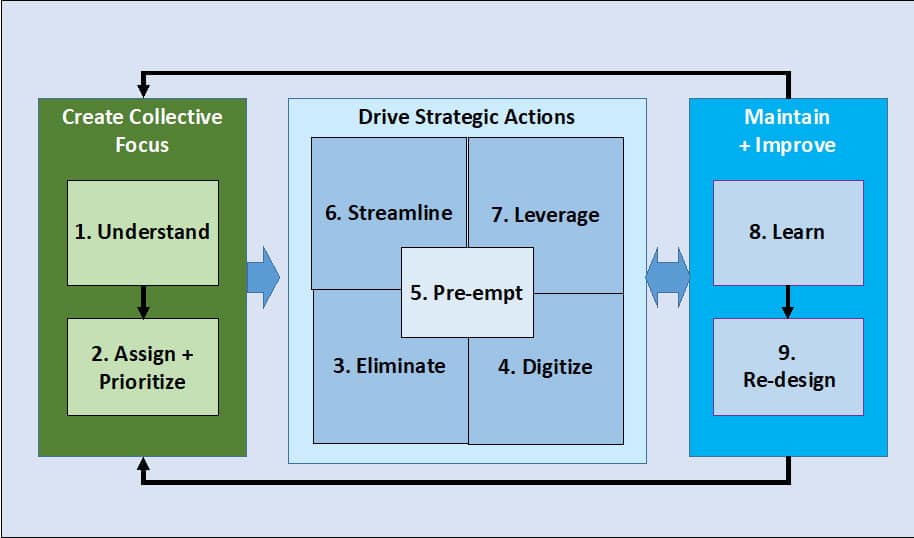The Benefits of a Frictionless Strategy

The media sometimes paints the picture that organizations that cut costs are also cutting corners and creating poor customer experiences. The assumption is that long waits on the phone, delayed flights, and confusing bills are all signs of cost-cutting at the customer’s expense. But this need not be the case if the organization’s changes include one thing: cutting out customer friction.
Customer friction is any interaction a customer initiates because a product or service doesn’t work, is late, or fails to meet expectations. Customer support areas are full of these signs of friction. They’re often in the form of complaints, such as “Where’s my delivery?” or “Why is my bill so high?” or “Why haven’t you finished the installation?”
With staff shortages and high turnover rates impacting many economies, tackling these frictions can help reduce the demand for customer service and lower required employee head counts, all the while vastly improving your customers’ experience. For example, a shorter customer phone call is better for your customer and your company. No need for a call at all is even better—and is truly frictionless!
Start With This Question
The key question regarding friction is: “Why did your customers have to contact you in the first place?” By starting with this position, CEOs and their teams can get to the root cause of customer frustration and then assess the feasibility of solutions. Could a customer problem be eliminated entirely? Could it be solved digitally? Could its processes be simpler?
These points of friction are easier to action than data and reports of averages like NPS or customer satisfaction scores, and they ultimately drive improvement in these indicators.
The potential of this strategy is fourfold:
- It reduces effort for the customer and costs for the business.
- It improves the reputation of the business, which, in turn, enables revenue growth.
- It creates a true competitive advantage because businesses with lower rates of failure can reinvest in price discounts or value-added services for customers.
- It protects a business against the threat of new entrants with lower friction and low-cost business models.
A Case in Point: Amazon
One of the best illustrations of this way of thinking is Amazon, which is often in the top 5 in national customer satisfaction ratings. Every year, Amazon works to reduce the cost of “failure demand” or friction. At one point, Amazon compared its rate of contacts per order with another online retail business and found the other business had more than 10 times the rate of contact. Amazon’s lack of friction provided a significant cost advantage (and clearly delights its customers).
Amazon achieves this by keeping customers informed throughout the order and shipping process and making it exceptionally easy to return a product. The speed of delivery of Amazon Prime is an attempt to remove another friction, namely one of delay. Amazon aspires to be frictionless for customers, and the company keeps finding new ways to improve.
Becoming Frictionless in 9 Steps
In order to become frictionless and create great customer experiences, we found that organizations need to follow these nine steps:

There are three stages to this process:
- Create focus: understand, assign, and prioritize. First, understand the points of friction from the interactions customers are already being forced to make, and then work out who is accountable and what should be prioritized. This understanding can include bringing in all costs and linking data to other information, such as NPS and customer attrition rates, to inform better decision-making. CEO sponsorship and target-setting for the accountable executives are essential to motivate the right actions.
- Drive strategic actions. Customer friction can be eliminated, remedied via digital solutions, preempted (by warning customers of problems), streamlined to reduce customer effort, or leveraged to make the best use of customer contacts. We list eliminate first as it’s the most fundamental and has the biggest impact. Getting rid of a problem is better than digitizing it because the customer still has work to do with a digital solution. Preempting can be useful for unexpected problems or resetting customer expectations. Streamlining and leveraging apply to interactions the organization wants but the customer often doesn’t, such as notification of a complaint.
- Maintain and improve. Finally, organizations must measure friction constantly and track improvements. Are frictions being addressed by the right departments? Are there new areas of friction? Should any solutions be redesigned? Do any need a radical overhaul? These evaluations are necessary because new problems and frictions occur all the time. These actions embed “removing friction” as a way of doing business.
If you aren’t convinced this is the right strategy for your business, this self-assessment may help:
- Do you understand the cost and volume of all customer contacts across your business?
- Do you understand the top 25 to 50 reasons for customer contacts? How are they changing? Have you totaled their costs?
- Do you understand which departments drive customer contacts? Do you hold those executives responsible for fixing them?
- Do you understand how the rate of contacts and their end-to-end costs have trended over time—and why?
- Do you understand the extent to which your customers have adopted and exploited your self-service?
- Do your systems and processes predict and preempt contacts?
- Have you been effective in improving the customer experience?
If you answer “no” to any of these questions, becoming frictionless will undoubtedly be a valuable strategy.
Written by Bill Price.
Have you read?
Best CEOs In The World, 2022.
Global Passport Ranking, 2022.
International Financial Centers Ranking, 2022.
World’s Richest People (Top Billionaires, 2022).
Economy Rankings: Largest countries by GDP, 2022.
Countries and territories with the largest population, 2022.
Top Citizenship and Residency by Investment Programs, 2022.
Bring the best of the CEOWORLD magazine's global journalism to audiences in the United States and around the world. - Add CEOWORLD magazine to your Google News feed.
Follow CEOWORLD magazine headlines on: Google News, LinkedIn, Twitter, and Facebook.
Copyright 2025 The CEOWORLD magazine. All rights reserved. This material (and any extract from it) must not be copied, redistributed or placed on any website, without CEOWORLD magazine' prior written consent. For media queries, please contact: info@ceoworld.biz








